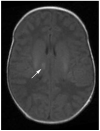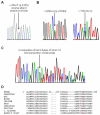Reversible infantile respiratory chain deficiency is a unique, genetically heterogenous mitochondrial disease
- PMID: 21931168
- PMCID: PMC4562368
- DOI: 10.1136/jmg.2011.089995
Reversible infantile respiratory chain deficiency is a unique, genetically heterogenous mitochondrial disease
Abstract
Objectives: Homoplasmic maternally inherited, m.14674T>C or m. 14674T>G mt-tRNA(Glu) mutations have recently been identified in reversible infantile cytochrome c oxidase deficiency (or 'benign COX deficiency'). This study sought other genetic defects that may give rise to similar presentations.
Patients: Eight patients from seven families with clinicopathological features of infantile reversible cytochrome c oxidase deficiency were investigated.
Methods: The study reviewed the diagnostic features and performed molecular genetic analyses of mitochondrial DNA and nuclear encoded candidate genes.
Results: Patients presented with subacute onset of profound hypotonia, feeding difficulties and lactic acidosis within the first months of life. Although recovery was remarkable, a mild myopathy persisted into adulthood. Histopathological findings in muscle included increased lipid and/or glycogen content, ragged-red and COX negative fibres. Biochemical studies suggested more generalised abnormalities than pure COX deficiency. Clinical improvement was reflected by normalisation of lactic acidosis and histopathological abnormalities. The m.14674T>C mt-tRNA(Glu) mutation was identified in four families, but none had the m. 14674T>G mutation. Furthermore, in two families pathogenic mutations were also found in the nuclear TRMU gene which has not previously been associated with this phenotype. In one family, the genetic aetiology still remains unknown.
Conclusions: Benign COX deficiency is better described as 'reversible infantile respiratory chain deficiency'. It is genetically heterogeneous, and patients not carrying the m.14674T>C or T>G mt-tRNA(Glu) mutations may have mutations in the TRMU gene. Diagnosing this disorder at the molecular level is a significant advance for paediatric neurologists and intensive care paediatricians, enabling them to select children with an excellent prognosis for continuing respiratory support from those with severe mitochondrial presentation in infancy.
Figures







References
-
- DiMauro S, Nicholson JF, Hays AP, et al. Benign infantile mitochondrial myopathy due to reversible cytochrome c oxidase deficiency. Trans Am Neurol Assoc. 1981;106:205–7. - PubMed
-
- DiMauro S, Nicholson JF, Hays AP, et al. Benign infantile mitochondrial myopathy due to reversible cytochrome c oxidase deficiency. Ann Neurol. 1983;14(2):226–34. - PubMed
-
- Roodhooft AM, Van Acker KJ, Martin JJ, et al. Benign mitochondrial myopathy with deficiency of NADHCoQ reductase and cytochrome c oxidase. Neuropediatrics. 1986;17:221–26. - PubMed
-
- Zeviani M, Peterson P, Servidei S, et al. Benign reversible muscle cytochrome c oxidase deficiency: a second case. Neurology. 1987;37(1):64–7. - PubMed
-
- Nonaka I, Koga Y, Shikura K, et al. Muscle pathology in cytochrome c oxidase deficiency. Acta Neuropathol. 1988;77:152–60. - PubMed
Publication types
MeSH terms
Substances
Grants and funding
LinkOut - more resources
Full Text Sources
Medical
Molecular Biology Databases
